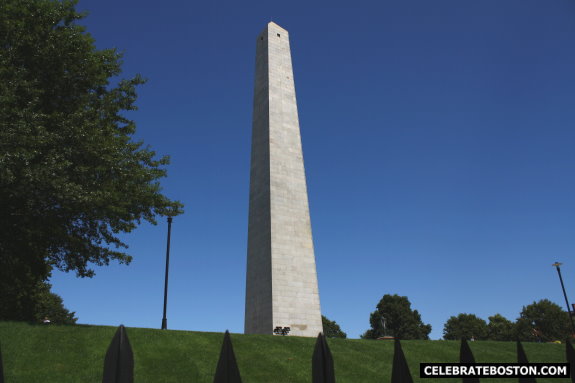 |
Home > Historic Sites | Freedom Trail
Bunker Hill Monument

Standing tall and proud in Charlestown, Massachusetts, the Bunker Hill Monument is not just an architectural marvel; it's a symbol of the indomitable spirit and sacrifice of the American Revolution. Rising 221 feet high into the sky, this iconic landmark commemorates the Battle of Bunker Hill, a crucial event that played a pivotal role in shaping the future of the United States. There is great historical significance, and a fascinating story behind this monumental tribute.
The Battle of Bunker Hill, fought on June 17, 1775, was one of the earliest and bloodiest clashes between British and American forces during the Revolutionary War. 4,000 British troops marched bravely up the hill, to almost certain death, and attacked the works that were hastily thrown up by the American (Provincial) troops during the previous night. The Americans numbered about 2,500, and were under the command ofColonel William Prescott, General Israel Putnam, andGeneral Joseph Warren. About 300 to 500 British troops were killed, with 600 or so wounded or missing, in their repeated attempts to storm the works. More than 100 Americans were killed, with 340 wounded or missing. Just before the battle, Prescott gave the famous command "don't fire til you see the whites of their eyes," to delay firing and conserve precious gun powder. There were many heroes at Bunker Hill, of lesser fame arePeter Salem, Salem Poor,andIsaac Freeman, all African-Americans. Although the battle took place primarily on Breed's Hill (misnamed as nearby Bunker Hill), it is remembered for the bravery displayed by the American militia against the well-trained British army.
The idea of erecting a monument to honor the Battle of Bunker Hill was conceived in the early 19th century. Dr. Joseph Warren, one of the patriots who perished in the battle, was initially honored with a small granite pillar on the site. However, the monument's construction faced numerous delays due to financial constraints, and it wasn't until 1823 that the Bunker Hill Monument Association was formed to oversee the project.
Designed by architect Solomon Willard, the Bunker Hill Monument draws inspiration from the ancient Egyptian obelisks. It is constructed primarily of granite quarried from nearby Quincy, Massachusetts. About 6,700 tons of granite were used in its construction. The obelisk tapers towards the top and stands on a square base, giving it a striking appearance that continues to captivate visitors.
On June 17, 1825, the 50th anniversary of the Battle of Bunker Hill, the monument's cornerstone was placed by Revolutionary War hero Marquis De Lafayette in a grand ceremony attended by President John Quincy Adam and former President James Monroe, before a crowd of thousands. About 40 veterans from the battle attended the ceremony. This event marked the official commencement of the monument's construction. After almost a decade of work, the Bunker Hill Monument was finally completed and dedicated on June 17, 1843. The monument's completion was a monumental achievement in itself, considering its sheer size and the technology available at the time.
Visitors to the Bunker Hill Monument can embark on a memorable journey by climbing the 294 steps leading to the top. Countless school children and residents have ambitiously attempted to make it to the top in one climb, but have found themselves lead-footed around two-thirds of the way up. The reward for this physical effort is an awe-inspiring panoramic view of Boston and its surroundings. For many, this experience is not only a tribute to the historical significance of the battle, but also a personal connection to the past.
Each year on June 17, the anniversary of the Battle of Bunker Hill, commemorative ceremonies are held at the monument. This tradition pays homage to the sacrifices made by the brave soldiers and serves as a reminder of the values that shaped the United States as a nation.
The Battle of Bunker Hill was a turning point in the American Revolution, bolstering the morale of the Continental Army and demonstrating that the colonists were willing to stand up against the British forces. Though the British technically won the battle, their heavy losses and the determination of the American forces foreshadowed their eventual defeat.
The Bunker Hill Monument stands not just as a historical marker but as a symbol of freedom, courage, and the relentless pursuit of liberty. It honors the sacrifices of those who fought for American independence and continues to inspire visitors from around the world with its timeless message of bravery and unity. It's a powerful testament to the American Spirit and the unwavering determination of its people. As it continues to stand tall, it reminds us of the sacrifices made by our forebearers and the values that remain the foundation of this great nation.
Related Information
CONTACT INFORMATION:
Bunker Hill Monument
Monument Square, Charlestown, MA 02129
617.242.5641
nps.gov
Nearest MBTA: Aquarium Station (Blue Line), and then Water Shuttle
Walking Directions: A very popular route to the Bunker Hill Monument and U.S.S. Constitution is via the Water Shuttle to Charlestown from Long Wharf (at the Marriott Hotel, a large brick structure). After debarking the boat in Charlestown, walk to the end of the dock and left to the Constitution Museum. Follow the Freedom Trail from there about 1/4 mile up the hill to the monument. The nearest MBTA stops are North Station and Community College on the Orange Line (20 minute walk).